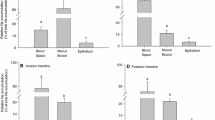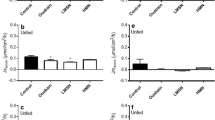Summary
The trophotaenial absorptive cells (TACs) in the goodeid teleosts, Xenotoca eiseni and Xenoophorus captivus facilitate macromolecular transport from mother to foetus. Various endocytic pathways operate in these cells as indicated by a highly compartmentalized vacuolar apparatus. A time-sequence analysis of the endocytotic activity involved in horseradish peroxidase (HRP) ingestion revealed that the solute marker was, for the most part, channelled to lysosome-like vacuoles. Alternatively, the electrostatic ligand cationized ferritin (CF) was also either transcytosed or regurgitated. In the TACs of Xenotoca eiseni, dose-dependent responses to ammonium ion (5 mM, 10mM, 20 mM), chloroquine (50 μM, 150 μM, 300 μM), and monensin (5 μM, 10 μM, 20 μM) were registered after incubation of embryos in HRP-saline supplemented with the respective reagents. Each drug produced qualitatively distinct structural alterations in the cell's vacuolar apparatus. Treatment with raising concentrations of NH4Cl caused progressive vacuolation. In a dose-related way, the chloroquine effect was reflected in the formation of a uniformly labelled labyrinthic membrane system, apparently a consequence of indiscriminate fusion events. Monensin-treated cells always had some densely labelled, lysosome-like vacuoles, but typical endosomes were for the most part missing. At higher concentrations of the ionophore, dense apical tubules progressively disintegrated. In the TACs of Xenoophorus captivus, CF-trafficking was traced in the presence of NH4Cl (10 mM), chloroquine (150 μM), or monensin (10 μM). Ammonia caused endosomal swelling and thus seemingly affected the lysosomal pathway, but recycling and transcytosis were qualitatively unaffected albeit at distinctly lower rates. After treatment with chloroquine, the ligand was uniformly distributed within a tubulo-lamellar membrane complex. Both recycling pathways and ligand processing pathways were probably blocked due to an indiscriminate fusion of vacuolar compartments. Monensin did not apparently inhibit lysosomal sequestration, but transcytotic vesicles were only rarely observed. A perturbation of the recycling mechanisms was indicated by the structural disintegration of many dense apical tubules.
Similar content being viewed by others
References
Basu SK, Goldstein JL, Anderson RGW, Brown MS (1981) Monensin interrupts the recycling of low density lipoprotein receptors in human fibroblasts. Cell 24:493–502
Brown WJ, Goodhouse J, Farquhar MG (1986) Mannose-6-phosphate receptors for lysosomal enzymes cycle between the Golgi complex and endosomes. J Cell Biol 103:1235–1247
Ciechanover A, Schwartz AL, Dautry-Varsat A, Lodish HF (1983) Kinetics of internalization and recycling of transferrin and the transferrin receptor in a human hepatoma cell line. J Biol Chem 258:9681–9689
Dean RT, Jessup W, Roberts CR (1984) Effects of exogenous amines on mammalian cells, with particular reference to membrane flow. Biochem J 217:27–40
Duve C de, Barsy T de, Poole B, Trouet A, Tulkens P, van Hoof F (1974) Lysosomotropic agents. Biochem Pharmacol 23:2495–2531
Graham RC Jr, Karnovsky KJ (1966) The early stages of absorption of injcted horseradish peroxidase in the proximal tubules of mouse kidney: ultrastructural cytochemistry by a new technique. J Histochem Cytochem 14:291–302
Griffiths G, Hoflack B, Simons K, Mellman I, Kornfeld S (1988) The mannose 6-phosphate receptor and the biogenesis of lysosomes. Cell 52:329–341
Leppla SH, Dorland RB, Middlebrook JL (1980) Inhibition of diphteria toxin degradation and cytotoxic action by chloroquine. J Biol Chem 255:2247–2250
Livesey G, Williams KE, Knowles SE, Ballard FJ (1980) Effects of weak bases on the degradation of endogenous and exogenous proteins by rat yolk sacs. Biochem J 188:895–903
Maxfield FR (1982) Weak bases and ionophores rapidly and reversibly raise the pH of endocytic vesicles in cultured mouse fibroblasts. J Cell Biol 95:676–681
Mellman I (1984) Membrane recycling during endocytosis. In: Dingle JT, Dean RT, Sly W (eds) Lysosomes in Biology and Pathology. Elsevier Science Publishers B.V. Amsterdam, pp 201–229
Mendoza G (1972) The fine structure of an absorptive epithelium in a viviparous teleost. J Morphol 136:109–130
Merion M, Sly WS (1983) The role of intermediate vesicles in the adsorptive endocytosis and transport of ligand to lysosomes by human fibroblasts. J Cell Biol 96:644–650
Ohkuma S, Poole B (1981) Cytoplasmic vacuolation of mouse peritoneal macrophages and the uptake into lysosomes of weakly basic substances. J Cell Biol 90:656–664
Oka AJ, Weigel PH (1987) Monensin inhibits ligand dissociation only transiently and partially and distinguishes two galactosyl receptor pathways in isolated hepatocytes. J Cell Physiol 133:243–252
Poole B, Ohkuma S (1981) Effect of weak bases on the intralysosomal pH in mouse peritoneal macrophages. J Cell Biol 90:665–669
Pressman BC (1976) Biological applications of ionophores. Annu Rev Biochem 45:501–530
Quintart J, Leroy-Houyet M-A, Trouet A, Baudhuin P (1979) Endocytosis and chloroquine accumulation during the cell cycle of hepatoma cells in culture. J Cell Biol 82:644–653
Rudnick G (1986) ATP-driven H+ pumping into intracellular organelles. Annu Rev Physiol 48:403–415
Schindler JF, Vries U de (1987a) Protein uptake and transport by trophotaenial absorptive cells in two species of goodied embryos. J Exp Zool 241:17–29
Schindler JF, Vries U de (1987b) Maternal-embryonic relationships in the goodeid teleost, Xenoophorus captivus. Embryonic structural adaptations to viviparity. Cell Tissue Res 247:325–338
Schindler JF, Vries U de (1988a) Maternal-embryonic relationships in the goodeid teleost, Xenoophorus captivus. The vacuolar apparatus in trophotaenial absorptive cells and its role in macromolecular transport. Cell Tissue Res 253:115–128
Schindler JF, Vries U de (1988b) Endocytosis at 0°C, 5°C, and 10°C in trophotaenial absorptive cells of goodeid embryos (Teleostei). Cell Tissue Res 254:399–402
Schmid SL, Fuchs R, Male P, Mellman I (1988) Two distinct subpopulations of endosomes involved in membrane recycling and transport to lysosomes. Cell 52:73–83
Schwartz AL, Bolognesi A, Fridovich SE (1984) Recycling of the asialoglycoprotein receptor and the effect of lysosomotropic amines in hepatoma cells. J Cell Biol 98:732–738
Seglen PO, Reith A (1976) Ammonia inhibition of protein degradation in isolated rat hepatocytes. Exp Cell Res 100:276–280
Seglen PO, Grinde B, Solheim AE (1979) Inhibition of the lysosomal pathway of protein degradation in isolated rat hepatocytes by ammonia, methylamine, chloroquine and leupeptin. Eur J Biochem 95:215–225
Singer SJ (1989) On the structure and function of endocytic transport systems. Biol Cell 65:1–5
Stein BS, Bensch KG, Sussman HH (1984) Complete inhibition of transferrin recycling by monensin in K 562 cells. J Biol Chem 259:14762–14772
Steinman RM, Mellman IS, Muller WA, Cohn ZA (1983) Endocytosis and the recycling of plasma membrane. J Cell Biol 96:1–27
Sullivan PC, Ferris AL, Storrie B (1987) Effects of temperature, pH elevators, and energy production inhibitors on horseradish peroxidase transport through endocytic vesicles. J Cell Physiol 131:58–63
Tartakoff AM (1983) Perturbation of vesicular traffic with the carboxylic ionophore monensin. Cell 32:1026–1028
Tietze Ch, Schlesinger P, Stahl P (1980) Chloroquine and ammonium ion inhibit receptor-mediated endocytosis of mannose-glycoconjugates by macrophages: apparent inhibition of receptor recycling. Biochem Biophys Res Commun 93:1–8
Tycko B, Maxfield FR (1982) Rapid acidification of endocytic vesicles containing α2-macroglobulin. Cell 26:643–651
Wibo M, Poole B (1974) Protein degradation in cultured cells. II. The uptake of chloroquine by rat fibroblasts and the inhibition of cellular protein degradation and cathepsin B1. J Cell Biol 63:430–440
Wileman T, Harding C, Stahl P (1985) Receptor-mediated endocytosis. Biochem J 232:1–14
Author information
Authors and Affiliations
Additional information
Supported by the Deutsche Forschungsgemeinschaft (Schi 268/1-1)
Rights and permissions
About this article
Cite this article
Schindler, J.F., de Vries, U. Effects of ammonia, chloroquine, and monensin on the vacuolar apparatus of an absorptive epithelium. Cell Tissue Res 259, 283–292 (1990). https://doi.org/10.1007/BF00318450
Accepted:
Issue Date:
DOI: https://doi.org/10.1007/BF00318450




